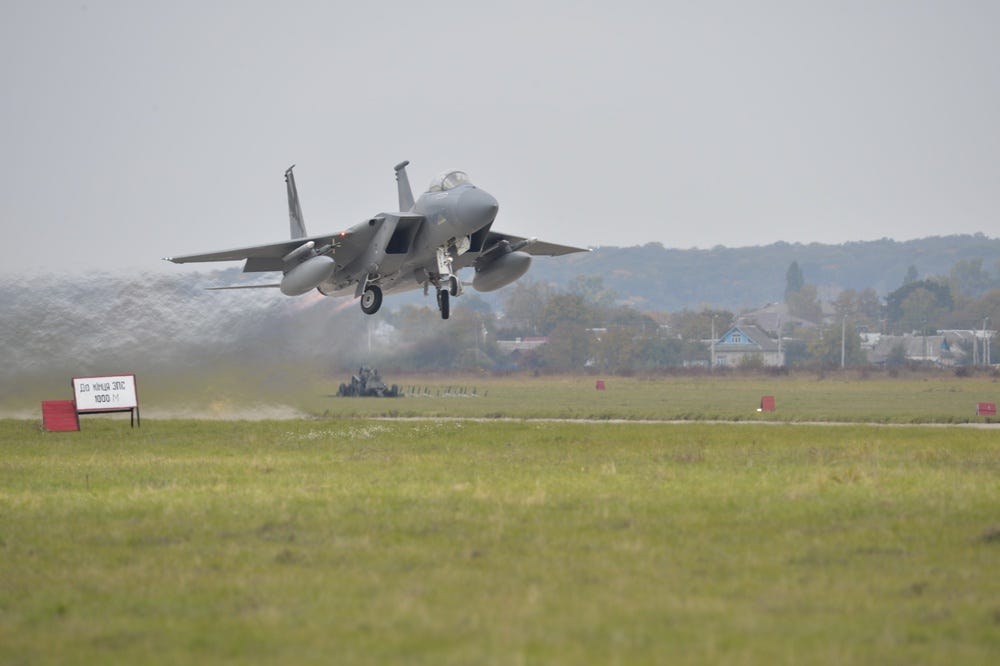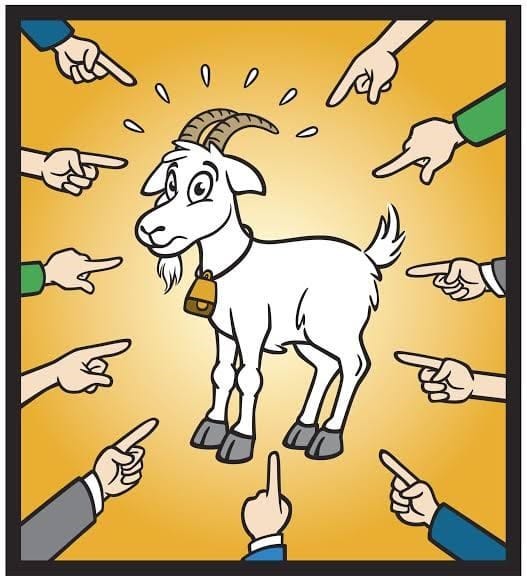Decades ago, I worked on a story about the crash of a US Air Force F-15 fighter plane. The crash killed the pilot. The investigation into the crash ended life as well and that’s the point.
Since, I’ve been fascinated with how people and organizations respond to crisis. More specifically, how the assignment of blame is carried out. Even more specifically, how a person or people are blamed for the mistakes of others. How they become the escaped goat.
I can trace this curiosity with scapegoats to a specific conversation. The origin of my interest. It was with a pilot. An active duty Air Force pilot who agreed to speak with me on background about the crash of this F-15.
It begins in May of 1995, in Germany. The F-15 Eagle, in this case, a single seat fighter plane. It accelerated down the runway. The sleek twin engine jet achieved takeoff speed. But instead of lifting off into the sky it careened into the ground. The pilot was killed instantly as an explosion destroyed the aircraft.
The investigation that followed found that rods for controlling the airplane in flight had been installed incorrectly. Simply, they had been reversed. The consequence? Up became down. Left became right. The plane could not be flown. A deadly error.
Painfully, this mistake was predictable. Actually, it was predicted, an easy mistake to make because of a design flaw in the F-15. A flaw the Air Force knew about. Well, not all of the Air Force. Just some people, in some parts.
“The search for a scapegoat is the easiest of all hunting expeditions.” - Dwight D. Eisenhower
Twice before this deadly crash in 1995 mechanics had made the same mistake. But in 1986 and 1991 disaster was averted when someone noticed things weren’t right. After the 1986 event a report was generated, it said, "cross-connecting the rods is an easy mistake to make." A second report added this point of concern, "we ought to fix it so they can't be connected wrong. " The Air Force did not fix the flaw. Compounding that dereliction of duty the powers that be didn’t notify mechanics that this potential mistake was “easy” to make. On a wing and a prayer is no way to fly.
Now, the flaw had finally taken life. Within weeks the Air Force set out to make the issue known to mechanics around the world. But that correction was not deemed enough. The Air Force mechanics who performed the work on the ill-fated aircraft were targeted for investigation and punishment.
The senior mechanic, with 17 years experience and a stellar reputation, became central to some sort of search for justice. The Air Force had their target.
A required legal review of the court-martial warned prosecutors that the mechanic might be seen as "a victim of poor policy" and a "mere scapegoat." Solution? Evidence to support these possibilities was excluded. At trial knowledge of the prior mishaps and flaw were not presented to the jury. The jury was also not permitted to hear about the corrective steps taken since the crash.
“It's too easy to criticize a man when he's out of favour, and to make him shoulder the blame for everybody else's mistakes.” - Leo Tolstoy, War and Peace
The zeal for punishment didn’t stop there. The Air Force intercepted the mechanics mail. Letters from a safety expert who wanted to help were kept from the defendants for months.
The Air Force invited the family of the dead pilot to the trial. They wanted testimony about their pain and suffering. Instead the Air Force got a letter from the pilot’s father. It asked for leniency. "This has already been a tragedy for all concerned," the father wrote.
The prosecution requested a gag order. It was granted by the judge. The Air Force Secretary rejected the defendants’ request to see a secret crash report that might help their case. A public statement by the Air Force's top safety official that the service had erred by not fixing the design flaw years earlier was deemed not relevant.
On the day the trial was set to begin the senior mechanic went missing. His car was found by a spot where he liked to fish and hunt with his sons. The Air Force organized a search. The mechanics father called out over a bullhorn, “Poppa is here.”
Searchers came across an elevated hunters’ stand. As one climbed the ladder a gunshot rang out. The mechanic had taken his life. In his last moments he wrote “I love you” to his wife on the stands window frame.
Soon after, the case against the second mechanic was dropped. The service declared that pursing the case was not in, “the interest of the Air Force.”
“Society has traditionally always tried to find scapegoats, well here I am.” - Marilyn Manson
Which brings us back to “pilot error.” That conversation so many years ago stuck with me. I ask the pilot on the phone, “what do you think will happen?” He chuckle a little and said, “Martin, it’s always pilot error.” Confused, I pressed him to explain. First, he told me most military aircraft don’t have data recorders. There is literally no “black box” information like that in a civilian crash. Thus, it is easier to blame the pilot.
But I also remember him saying, “not literally. ” He explained that what he meant is that they will never blame the big problem. They will never go after the big guy. “Too big to fail” comes to mind. You never blame the service or a multi-million dollar plane borne of a multi-billion dollar defense contact.
I carried this lesson, moment, with me in the years that followed. For one, I used it to govern the work I did and supervised. Don’t go after the easy target. One line I’d use with staff and myself went something like this, “should we use a cannon to kill that fly?” This is a point about proportionality. Do we make some meager bit player the focus of story on insurance fraud that benefits a massive company in far greater ways? It isn’t always easy to decide. But, “can we?” and “should we?” are questions that need to exist in consort.
That leads to the second point of all this. As consumers of news, content, media we often get fed the little guy to fuel our fury. A city’s leaders fail to fund the police or mental health services properly. The cover of the paper? Some poor broken soul urinating on the street. Its likely they aren’t there solely because of bad luck, choices were made. But, be certain, vilifying that individual won’t solve the problem. This habit covers a broad spectrum of issues. The Great Chicago Fire, blame a cow - Eve, Adam gets a pass - Bill Buckner, he did not lose the 1986 World Series alone. The list goes on. Much of it is absurd. Like a political pundit who blames a Super Mario Brothers movie for rape and feminism. I’m annoyed I know about that, I blame myself. I also know some people will blame Mario.
Be mindful of the way rage is delivered to you. The way it lets you target anger at a specific party while shielding the actual and more complex culprits behind the chaos and calamity. It simply satiates our desire to see someone blamed. With blame assigned we enjoy relief as those with the responsibility and power to fix an issue enjoy another day in the sun and out of the spotlight. Be mindful of letting the “pilot” face the blame when the way we “fly” is the real problem.
Author’s Note: I used no names in the writing of this. Why? Because it doesn’t matter. This story has happened countless times and it will continue. We kill mosquitos with cannons. Until we decide we won’t anymore.





